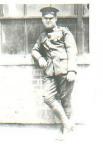CPL Oscar L. Sprague – MIA - Korea
My name is Peter Duston and I am the adjutant for Narraguagus Post 8. Our post organized a memorial service that was a yearlong effort to bring some closure to Oscar Sprague’s family, who have waited 70 years to have a place – a stone, a flag and a proper memorial program to remember their brother and uncle. Oscar’s photo sits on the POW/MIA Remembrance Table in our Legion Hall where we have acknowledged him, spoken his name and remembered him. It is finally fitting that we say his name and remember his sacrifice in this place where his parents are buried, the parents who waited their entire lives after that fateful day in 1950 for their son to come home. As taps sounded and the Honor Guard NCOIC held his salute after presenting the flag on behalf of a grateful nation, the folded flag was passed slowly from youngest to oldest of Oscar Sprague’s five surviving sisters. There was hardly a dry eye in the assembled attendees. The youngest sister, with tears in her eyes said: “We have waited 70 years for this closure.” Military Honors - Sept 5, 2020.
CPL Oscar L. Sprague, a resident of Milbridge, born Oct 5, 1927, was a regular Army soldier assigned to Company H, 2nd Battalion, 9th Infantry Regiment, 2nd Infantry Division. He was reported as an MIA on Sept 3, 1950, and later as a KIA, remains not recovered.
The Korean War began when the North Korean army invaded the South on June 25, 1950. The 2nd Infantry Division was quickly alerted at Fort Lewis, Wash., and arrived in Pusan, South Korea, on July 23, 1950, becoming the first unit to reach Korea directly from the United States. Like all units early to arrive in Korea, the 2th ID was employed piecemeal to stem the tide of the invading communists. The entire division was committed as a unit on Aug. 24, relieving the 24th Infantry Division at the Naktong River Line. A 16-day battle began on the night of Aug. 31, 1950, that required the Warrior Division's clerks, band and logistics personnel to join in the fight to hold the "Pusan Perimeter." The Perimeter was the United Nations' effort to form a main battle line to finally stop the advancing North Koreans.
The North Koreans, expecting light resistance from what they thought were exhausted troops, did not expect the fresh troops of the 2nd Division and began piecemeal incursions in the area of Agok along the Naktong River. U.S. patrols reported North Korean activity on the other side of the river and sent a company-size combat patrol across to capture prisoners for intelligence purposes. A section of light machine gunners from PFC Sprague’s Company H accompanied the patrol, dubbed “Operation Manchu.” We don’t think PFC Sprague was on the patrol. We do know that 1LT Edward Schmitt, H Company commander, moved the remainder of the company including PFC Sprague with weapons to the base of Hill 209 overlooking the ferry crossing and set their mortars and machine guns. A full-strength company had about 175 soldiers. The North Koreans crossed the river at night and caught the mortars unprepared and mounted a fierce attack against Company D and H, PFC Sprague’s company. Many of the Americans were either killed or captured. PFC Sprague, apparently, survived this attack and was likely with the remnants of D and H companies and the heavy mortar-carrying team that had made it to the top of Hill 209. The North Koreans did not attack up the hill that night, giving the surviving H Company soldiers a frightening breather. With PFC Sprague’s unit were a few survivors of Company B, men from D and the Heavy Mortar Platoon, altogether 60 to 70 men with a radio, a heavy machine gun, a BAR, about 20 M1 rifles and maybe 40 carbines and pistols. 1LT Schmitt was the surviving officer in charge. The morning of Sept. 2 dawned with the small group of survivors surrounded by North Koreans with more streaming in from the river crossing. The first attack against the outnumbered Americans came about 1400 in the afternoon and was repulsed. During the night, they were attacked three more times by a company-sized communist unit, each time pressing into close quarters but repulsed by the American infantrymen. Task Force Manchu was holding on by their fingernails. Daylight revealed scores of North Korean dead surrounding the American troops dug in on the hilltop. That afternoon, Schmitt radioed for an airdrop of supplies desperately needed, but the defensive perimeter was so tight that the supplies landed in the hands of the enemy. A PFC Quellette risked himself to gather weapons and ammunition from the Korean dead.
That same afternoon of the 2nd, the North Koreans sent an American prisoner up the hill to 1LT Schmitt demanding surrender or else. Defying the order, Schmitt and the surviving soldiers came under heavy mortar and machine gun fire from an adjoining hilltop controlled by the enemy keeping the defending Americans down in their foxholes. That night, the North Koreans sent more frontal attacks up the hill and again they were repulsed.
The morning of the 3rd, the situation worsened with hot weather and shortage of supplies. There were multiple infantry attacks and constant fire from the enemy machine guns and mortars on the adjacent hill. Dead and dying U.S. troops were in every foxhole. The radio was destroyed leaving the defenders without air or artillery support. Enemy soldiers worked close enough to the perimeter to throw many grenades. PFC Quellette leaped from his foxhole multiple times to escape grenades but was killed in the close action. 1LT Schmitt was also killed, leaving 1LT McDaniel in charge. PFC Sprague was reportedly killed during this action.
The following morning, head count revealed only about half the original force was alive with two officers. They managed to survive the day and when they were down to one clip (8 rounds) per man and a few grenades, 1LT McDaniel organized a withdrawal under cover of darkness. Of the 29 men who came down off the hill, 22 made it back to friendly lines hiding by day and traveling by night. PFC Quellette and MSG Travis Watkins both were posthumously awarded the Medal of Honor. Although PFC Sprague and so many others were lost, the survivors of Task Force Manchu brought valuable intelligence on the North Korean tactic along the river crossings. The communists floated pontoon bridges across the Naktong River by night and dismantled and hid them by day to avoid being shelled or bombed by the U.S. forces.
Although the American losses were great, the 2nd Division and the adjacent Marine unit held the Pusan Perimeter and by the end of the battle had decimated two North Korean divisions. On Sept. 16, 1950, one day after the Inchon landing, the 2nd Infantry Division was the first unit to break out of the Pusan Perimeter. The Indianhead Division led the 8th Army drive to the Manchurian border. The division was within 50 miles of the Manchurian border when Chinese forces entered the fight, first encountering American troops on November 1, 1950. Soldiers of the 2nd Infantry Division were given the mission of protecting the rear and right flank of the 8th Army as it retired to the South. Fighting around Kunu-ri cost the 2nd ID nearly one-third of its strength, but was 10 times more costly to the enemy. Routes south were kept open.
The “Manchu” heroes of Hill 209 were recognized by their regimental commander as putting up an incredible resistance. The original “Secret” battle files refer to the “…heroic stand made by a small group of “Manchu” men, living up to the highest traditions of the Regiment, did, in spite of the bitterly contested hill 201 (209) and the suicidal efforts of the inhuman Communist Armies…”
As we now know, the United Nations forces stopped the Chinese advance near the 38th parallel just north of Seoul, the capital of South Korea. An armistice was declared in June 1953 that established a DMZ between the two Koreas that exists still today.
When the prisoner exchanges were made following the cease fire, CPL Sprague was neither among the prisoners nor was his name on a list of those who died in captivity, so it was presumed that he was killed on Sept. 3, 1950, that day of fierce fighting on Hill 209. He was posthumously promoted to CPL while an MIA. His remains have never been recovered, hence the initial MIA status, but there are ongoing recovery efforts by Army forensic teams searching former battle sites. Perhaps, just perhaps as there has been with others, there will be a recovery and burial back home with military honors.
His awards would include: The Combat Infantryman Badge, Purple Heart, Bronze Star, Korean War Medal, POW/MIA Medal, National Defense medal, Korean Service Medal, ROK Presidential Unit Citation, UN Service Medal, ROK War Service Medal
RIP CPL Oscar L. Sprague in the highest traditions as a “Manchu” warrior!
From the 9th Regiment war diary following the battle of Hill 209: “These men of Hill 209 shall always be remembered for they were truly “Manchu” men living up to the very highest traditions and standards of the “Manchu” Regiment. Words will never describe the mental and physical torture endured so that freedom and America may continue to exist against Communism.”
Information gathered from formerly classified Korean War records and websites by Legion Post 8 Adjutant Peter Duston.
Footnote: Oscar Sprague lied about his age and served three months in WWII as a 15-year-old, before being sent home with an honorable discharge. He re-enlisted in the Regular Army before the Korean War. He is therefore credited with both wars.



